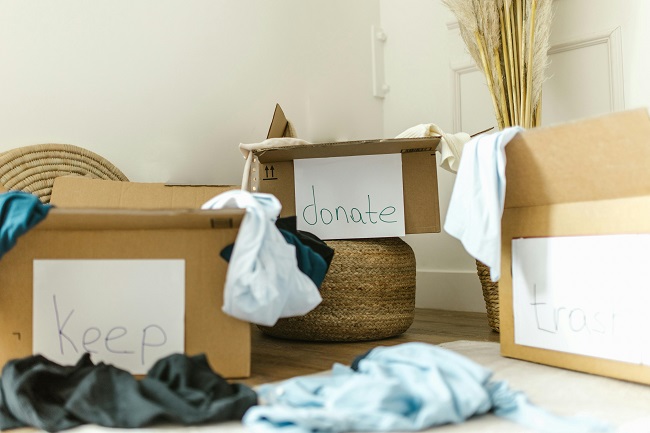Keeping your home organized and clutter-free requires more than just a one-time deep clean. The key to how to maintain a clutter-free home is developing sustainable habits that prevent clutter from creeping back in. Many people experience a decluttering relapse, where items gradually accumulate despite their best efforts. However, with the right strategies, you can create a home that stays organized for the long term.
By following decluttering tips, implementing home organization strategies, and building a clutter-free mindset, you can enjoy a minimalist lifestyle that makes daily living easier and more peaceful. This guide will help you master how to maintain a clutter-free home with practical solutions for every space.
The Benefits of a Clutter-Free Space
Mental Health Improvements in a Clutter-Free Home
A cluttered home often leads to a cluttered mind. Studies show that excessive clutter can contribute to stress, anxiety, and even feelings of depression. A well-organized space, on the other hand, promotes relaxation and enhances mental clarity.
Key mental health benefits of a clutter-free home include:
- Reduced Stress – A clean environment minimizes mental overwhelm.
- Improved Mood – Living in an organized space can enhance your overall well-being.
- Better Sleep – A tidy bedroom creates a restful atmosphere, improving sleep quality.
Decluttering is a form of self-care that allows you to create a more peaceful and balanced home environment.
Increased Productivity
A clutter-free space doesn’t just improve mental health—it also enhances productivity. Whether you work from home or simply want to complete daily tasks more efficiently, an organized home can help you stay focused.
How clutter-free spaces boost productivity:
- Less Time Spent Searching for Items – When everything is in its place, you waste less time looking for lost items.
- Fewer Distractions – A clean space allows for better concentration.
- More Motivation to Keep Areas Tidy – When your home is already organized, it’s easier to maintain good habits.
By eliminating distractions and unnecessary mess, you create an environment that fosters efficiency and motivation.
Practical Steps for How to Maintain a Clutter-Free Home
1. Embrace the “One-In, One-Out” Rule
The One-In, One-Out rule is a simple yet effective strategy for preventing clutter buildup. Each time you bring a new item into your home, commit to removing one similar item. This prevents new possessions from accumulating and helps you maintain a balanced number of belongings.
How to Implement One-In, One-Out
- Apply It to New Purchases: Whenever you buy something new, immediately choose a similar item to donate, sell, or discard.
- Extend It to Gifts and Keepsakes: The rule can also apply to gifts or sentimental items you receive. To keep things balanced, part with an old item of similar use or meaning.
- Create a Donation Station: Keep a designated box for items that you’re ready to donate. Each time you bring something in, place an outgoing item in the box.
The One-In, One-Out rule helps you stay intentional about what you bring into your home, keeping clutter in check and making each possession more meaningful.
2. Practice Regular “Mini Declutters”
Clutter can sneak back in if you’re not vigilant, so integrating regular mini-declutter sessions into your routine is essential. These short, focused sessions help maintain your space without overwhelming you.
Tips for Effective Mini Decluttering
- Set a Weekly or Monthly Schedule: Choose a day each week or month to do a quick sweep of clutter-prone areas, like countertops or closets.
- Use a Timer: Set a timer for 10-15 minutes to prevent burnout. Focus on one specific area, like a drawer or shelf, and clear it of any unwanted items.
- Rotate Through High-Clutter Zones: Pay attention to areas that tend to gather clutter, like entryways, kitchen counters, or living room surfaces, and revisit these spots regularly.
Mini decluttering sessions are like “clutter check-ups” that keep your home organized without requiring large time commitments.
3. Set Boundaries for Your Belongings
Setting boundaries for how many items you own within a category helps prevent clutter relapse by limiting unnecessary accumulation. This can apply to anything from clothes and books to kitchenware and decor.
How to Set Boundaries for Belongings
- Define Quantity Limits: Decide on a specific number for each category. For example, limit yourself to 20 pairs of shoes or 10 coffee mugs. This reduces decision fatigue and creates natural stopping points.
- Use Containers and Storage Bins: Use baskets, bins, or shelves to contain categories of items. When a container is full, it signals that you may need to declutter.
- Limit Displayed Decor: Rotate seasonal decor or artwork to keep your space feeling fresh without adding clutter.
By setting boundaries, you create a natural limit that helps you evaluate whether new items truly add value to your life.
4. Develop Mindful Shopping Habits
One of the quickest paths back to clutter is through mindless shopping, which can lead to impulse buys and unnecessary accumulation. Practicing mindful shopping encourages you to be more intentional about each purchase.
Strategies for Mindful Shopping
- Make a List Before You Buy: Keep a shopping list of only the essentials you need. Sticking to this list reduces impulse buys.
- Wait 24 Hours Before Buying Non-Essentials: Give yourself a “cooling-off” period to evaluate whether a new item is truly necessary.
- Ask Yourself Key Questions: Before making a purchase, ask questions like, “Do I really need this?” or “Where will it go?” These questions prevent impulse buying and keep you from filling your home with clutter.
Mindful shopping helps you stay intentional with purchases, ensuring that only meaningful and useful items make it into your space.
5. Make Decluttering a Shared Habit
If you live with family or roommates, their habits can influence how quickly clutter builds back up. Working together to establish clutter-free habits as a household makes it easier to avoid a relapse.
Tips for Making Decluttering a Group Effort
- Have a Family Declutter Day: Choose one day a month where everyone works together to tidy and declutter shared spaces.
- Create a “Return to Home” Routine: Get everyone on board with returning items to their designated places at the end of each day. This habit keeps surfaces clear and reduces clutter accumulation.
- Set Shared Rules for Common Areas: Agree on basic rules for keeping common areas like the living room or kitchen tidy. For example, decide together to keep countertops clear or to limit decor.
Creating household routines around decluttering encourages everyone to take part in maintaining a clutter-free space, making it easier to avoid a relapse.
6. Regularly Reevaluate Your Sentimental Items
Sentimental items are often a source of clutter, as they carry emotional significance and can be hard to let go. Periodically reevaluating these items helps ensure that only the most meaningful things remain in your space.
How to Reevaluate Sentimental Items
- Set a Review Schedule: Revisit your sentimental items every six months to a year. This allows you to assess their value over time.
- Ask Meaningful Questions: When looking at each item, ask yourself if it still holds the same meaning or if it’s taking up valuable space.
- Digitize Memories: Consider taking photos of sentimental items to preserve memories without keeping physical clutter.
By reassessing sentimental belongings, you give yourself permission to let go of items that may no longer hold the same significance, keeping only what truly matters.
7. Embrace Functional and Purposeful Storage Solutions
Clutter is more likely to return if items don’t have designated storage spots. Embracing functional and purposeful storage solutions helps maintain a tidy home and prevents items from piling up in random places.
Storage Tips to Keep Clutter at Bay
- Designate “Homes” for Each Item: Assign a specific spot for everything, from remotes and keys to kitchen utensils and shoes.
- Use Clear Containers for Visibility: Clear containers or labeled bins make it easy to see what’s inside, helping you avoid buying duplicates.
- Maximize Vertical Space: Install shelves or hooks to take advantage of vertical storage in closets, kitchens, and entryways.
Functional storage solutions help you stay organized, ensuring that everything has a place and reducing the chances of clutter building up.
8. Implement Daily Reset Routines
Creating daily reset routines is a powerful habit for keeping clutter from creeping back in. A few minutes each day spent tidying can prevent small messes from turning into overwhelming clutter.
How to Implement Daily Reset Routines
- Do a 5-Minute Evening Tidy-Up: Take five minutes each evening to put things back where they belong. This could include folding blankets, placing dishes in the dishwasher, or clearing your work desk.
- Create a “Nightly Sweep” Checklist: Make a quick checklist of daily reset tasks, like clearing counters, putting away shoes, or straightening pillows.
- Get the Whole Family Involved: If you live with others, make it a household routine to spend a few minutes tidying each night. This habit ensures everyone contributes to maintaining a clutter-free space.
A daily reset routine prevents clutter buildup by addressing it before it becomes overwhelming, making it easier to maintain a peaceful, organized environment.
Maintaining Your Clutter-Free Home with Long-Term Habits
Daily Routines for Staying Organized
- Five-minute evening reset – Put everything back in its designated place.
- One-in, one-out rule – Anytime you bring in a new item, remove an old one.
- Tidy as you go – Clean up small messes immediately.
Seasonal Decluttering Habits to Keep a Clutter-Free Home
A clutter-free home isn’t just about daily maintenance—it’s also about seasonal resets.
- Spring and summer – Rotate clothes and declutter seasonal decor.
- Fall and winter – Organize holiday decorations and cold-weather essentials.
By making decluttering a habit, you ensure that your home remains organized year-round.
Common Challenges in Maintaining a Clutter-Free Home and How to Overcome Them
Overcoming Emotional Attachment to Items
Many people struggle to part with sentimental objects.
- Take photos of sentimental items instead of keeping everything.
- Keep only a few meaningful pieces rather than an entire collection.
- Donate items to someone who will truly appreciate them.
Managing Family and Shared Spaces Without Clutter
- Set household rules for organization.
- Create shared storage solutions for common areas.
- Encourage family members to take ownership of their personal spaces.
A clutter-free home requires teamwork, especially in shared living spaces.
Conclusion: Embracing a Clutter-Free Lifestyle
Maintaining a clutter-free home isn’t about perfection—it’s about consistency. By adopting simple habits like daily tidying, mindful shopping, and seasonal purging, you can keep your home organized without feeling overwhelmed.
A minimalist lifestyle or structured home management routine allows you to enjoy a peaceful, stress-free space. Whether you’re decluttering for the first time or looking for ways to maintain organization, the key is to create systems that work for you.
Start small, stay consistent, and enjoy the long-term benefits of a clutter-free home.

